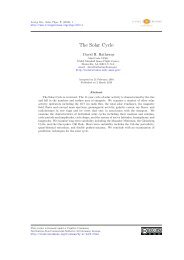PDF (for b&w printout) - Living Reviews in Solar Physics
PDF (for b&w printout) - Living Reviews in Solar Physics
PDF (for b&w printout) - Living Reviews in Solar Physics
You also want an ePaper? Increase the reach of your titles
YUMPU automatically turns print PDFs into web optimized ePapers that Google loves.
The Sun <strong>in</strong> Time: Activity and Environment 13<br />
Table 2: The “Sun <strong>in</strong> Time” project: Relevant observations.<br />
Instrument Wavelength range Energy range References a<br />
( ˚A) (keV)<br />
XMM-Newton (CCDs) 0.83 – 83 0.15 – 15 1<br />
XMM-Newton (grat<strong>in</strong>gs) 6.0 – 38.0 0.33 – 2.1 1<br />
ASCA (CCDs) 1.2 – 31 0.4 – 10 2<br />
ROSAT (PSPC) 5.2 – 124 0.1 – 2.4 2, 3, 4, 5<br />
EUVE (grat<strong>in</strong>gs) 80 – 760 b 0.016 – 0.15 5, 6, 7, 8<br />
FUSE (grat<strong>in</strong>gs) 920 – 1180 9<br />
HST (grat<strong>in</strong>gs) 1150 – 1730 8<br />
IUE (grat<strong>in</strong>gs) 1150 – 1950 10<br />
UBVRI photometry 3500 – 8300 11, 12<br />
VLA (cont<strong>in</strong>uum) 3.6 cm/8.4 GHz 2, 3, 13, 14, 15, 16<br />
a References: 1 Telleschi et al. (2005); 2 Güdel et al. (1997b); 3 Güdel et al. (1995c); 4 Dorren et al. (1995); 5<br />
Ayres (1997); 6 Güdel et al. (1997a); 7 Audard et al. (1999); 8 Ribas et al. (2005); 9 Gu<strong>in</strong>an et al. (2003); 10<br />
Dorren and Gu<strong>in</strong>an (1994a); 11 Mess<strong>in</strong>a and Gu<strong>in</strong>an (2002); 12 Mess<strong>in</strong>a and Gu<strong>in</strong>an (2003); 13 Güdel et al.<br />
(1994); 14 Güdel et al. (1995b); 15 Gaidos et al. (2000); 16 Güdel and Gaidos (2001).<br />
b Wavelengths longer than ≈ 360 ˚A are subject to strong <strong>in</strong>terstellar absorption.<br />
3.2 Overview of stellar sample<br />
The program uses a homogeneous sample of s<strong>in</strong>gle nearby G0-5 V MS stars (and one G2 IV<br />
subgiant) that all have known rotation periods and well-determ<strong>in</strong>ed physical properties, <strong>in</strong>clud<strong>in</strong>g<br />
temperatures, lum<strong>in</strong>osities, metal abundances and ages (Table 3). Observations cover spectral<br />
ranges from radio to X-rays (exclud<strong>in</strong>g the 360 – 920 ˚A range, which is a region of very strong<br />
absorption by the <strong>in</strong>terstellar medium). The pr<strong>in</strong>cipal stellar sample is given <strong>in</strong> Table 3; the<br />
samples used <strong>for</strong> particular studies may vary somewhat, depend<strong>in</strong>g on the availability of appropriate<br />
observational data. The parameters collected <strong>in</strong> this table are from Dorren and Gu<strong>in</strong>an (1994a),<br />
Güdel et al. (1997b), Güdel et al. (1998b), Güdel and Gaidos (2001), Gu<strong>in</strong>an and Ribas (2002),<br />
Ribas et al. (2005), and Telleschi et al. (2005). Bolometric lum<strong>in</strong>osities have been derived from<br />
absolute visual magnitudes, MV, by apply<strong>in</strong>g standard bolometric corrections. I briefly summarize<br />
the magnetic-activity properties of a few important “Young Suns” that will be discussed extensively<br />
<strong>in</strong> this paper (further notes can be found <strong>in</strong> Ribas et al. 2005).<br />
EK Draconis = HD 129333 is an exemplary near-ZAMS solar analog, represent<strong>in</strong>g the very<br />
active young Sun at the time when planetary atmospheres first <strong>for</strong>med. EK Dra is a member of<br />
the Pleiades Mov<strong>in</strong>g Group at a distance of 34 pc. König et al. (2005) estimated an age of only<br />
35 Myr, and a mass of (0.9 – 1.0)±0.1 M⊙. EK Dra’s optical and UV properties have been studied <strong>in</strong><br />
detail by Dorren and Gu<strong>in</strong>an (1994a). With a rotation period of 2.7 d, it reveals extreme magnetic<br />
activity, show<strong>in</strong>g a photospheric spot coverage of 6% (Dorren and Gu<strong>in</strong>an 1994a, larger fractions<br />
were given by König et al. 2005), transition-region l<strong>in</strong>e fluxes 20 – 100 times larger than the Sun’s<br />
(Dorren and Gu<strong>in</strong>an, 1994a), a very hot X-ray emitt<strong>in</strong>g corona with a lum<strong>in</strong>osity ≈ 1000 times<br />
the present-day solar X-ray output (Güdel et al., 1997b; Telleschi et al., 2005), and an extremely<br />
lum<strong>in</strong>ous non-thermal radio corona exceed<strong>in</strong>g radio lum<strong>in</strong>osities of strong solar flares by orders<br />
of magnitude (Güdel et al., 1994, 1995c). EK Dra shows rotational modulation from spots <strong>in</strong><br />
the optical, and due to <strong>in</strong>homogeneous coronal active regions also <strong>in</strong> the radio and X-ray regimes<br />
(Güdel et al., 1995c). It further shows strong evidence <strong>for</strong> a ≈ 10 yr activity cycle (Dorren and<br />
<strong>Liv<strong>in</strong>g</strong> <strong>Reviews</strong> <strong>in</strong> <strong>Solar</strong> <strong>Physics</strong><br />
http://www.liv<strong>in</strong>greviews.org/lrsp-2007-3



